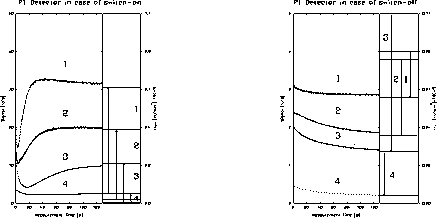




The signal from the photoconductive detectors of the PHT instrument do not instantaneously adjust to the imposed illumination level. There is a transient period during which the detector signal approaches its final level (see Fig. 5).

It can be seen that the shape of the drift curve also depends on the amplitude
of the flux step and the direction of the flux change (low
 high or high
high or high  low). This behaviour
demonstrates that the photometric accuracy depends not only on the
signal-to-noise ratio with which a source is detected but also on the
deviation from the final signal level during these transient periods. These
signal drifts can be fitted with physically meaningful model functions.
However, a minimum measurement time is needed in
order to make a reliable flux determination.
low). This behaviour
demonstrates that the photometric accuracy depends not only on the
signal-to-noise ratio with which a source is detected but also on the
deviation from the final signal level during these transient periods. These
signal drifts can be fitted with physically meaningful model functions.
However, a minimum measurement time is needed in
order to make a reliable flux determination.
Experience with data obtained during ground tests of the instrument shows that measurement times of 32 seconds enable fitting the data and derivation of the final signal level which is within 5% of the true signal level achieved with the detector after a long undisturbed stabilization time. Flux changes always occur when changing the beam path, i.e. when changing filters or apertures or when moving with the telescope over brightness gradients on the sky. There are also short intermediate dark phases when rotating the filter/aperture wheels and thus a complex illumination history of the detectors will occur which will not be predictable in general. Since a wide range of illumination powers shall be measured, standard flashes with the internal reference sources before the measurement may not be helpful to achieve a more controlled illumination history, as big flux differences between flash and target brightness would also lead to strong drift effects.
Therefore, to cope best with the unavoidable drifts, when a good relative photometric accuracy of a few percent is required for a single-pointing observation, sufficiently long on-source integration times (at least 32 seconds) should be selected, even when the desired signal-to-noise ratio can be achieved during considerably shorter times. If only detection of the source with photometric accuracies of the order of 30% is aimed for, shorter measurement times can be used. For mapping when the illumination level is relatively homogeneous and no large brightness gradients occur shorter integration times per raster point of the order of 10 to 30 seconds can be used.
Large flux differences over short time periods should be avoided; therefore, chopping should only be used for the detection of faint sources relative to the background (see Section 2.11), i.e. for sources which have a similar or smaller contribution to the total flux than the underlying background. Bright sources should in general be measured in staring mode.
Furthermore, the design of the PHT AOTs makes several provisions in order to minimise drift effects:



